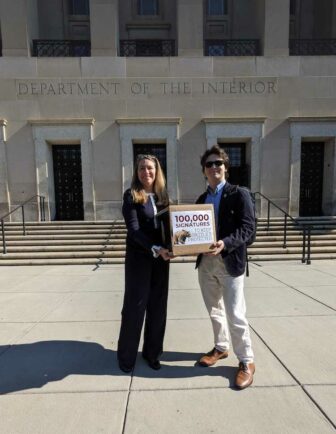For Immediate Release: May 22, 2024
Contact:
Adam Rissen, WildEarth Guardians, arissien@wildearthguardians.org
Derek Goldman, Endangered Species Coalition, dgoldman@endangered.org
Grace Kuhn, Western Watersheds Project, grace@westernwatersheds.org
Ian Brickey, Sierra Club, ian.brickey@sierraclub.org
Andrea Zaccardi, Center for Biological Diversity, azaccardi@biologicaldiversity.org
Wildlife Activists Urge Continued Grizzly Bear Protections
100,000 Petition Signatures Delivered to Sec. Haaland as Grizzly Bear Images Light Up Interior Building
Washington, D.C.– Wildlife advocates appeared twice at the Department of Interior this week, urging Secretary of Interior Deb Haaland and the U.S. Fish and Wildlife Service (FWS) to maintain Endangered Species Act protections for grizzly bears in the Northern Rockies.

On Monday evening near dusk, grizzly bear images were projected onto the Department of Interior building, along with large lettering urging the Department to keep grizzly bears protected.
On Wednesday morning, activists arrived at the Department of Interior to present Sec. Haaland with more than 100,000 signatures on petitions urging the FWS to keep grizzly bears protected under the Endangered Species Act. The wildlife agency is currently conducting a species status assessment for grizzly bears in the northern Rockies, in response to petitions from the states of Montana and Wyoming–the first step in removing them from the Endangered Species list. Wildlife advocates are concerned that delisting grizzly bears and turning full management over to states would result in more deaths, even as grizzly bears have yet to fully recover in the northern Rockies and continue to face numerous threats.
The advocates’ letters to Sec. Haaland and USFWS Director Martha Williams reads, in part:
“With states like Montana, Wyoming and Idaho becoming more aggressive towards large carnivores in recent years, this is not the time to remove federal protections for grizzly bears. The state management plan in Montana, along with recently-passed legislation, indicates a much more aggressive use of lethal control in response to livestock conflict, and a reduced state tolerance for grizzly bears in some areas. It also shows a lack of commitment to connecting and recovering isolated populations of grizzly bears, should any other population lose federal protection and oversight.”
“Now is not the time to remove grizzly bear protections,” said Adam Rissien, ReWilding Manager with WildEarth Guardians. “Grizzlies continue to remain isolated from each other, and some recovery areas struggle to support bears or have no populations at all. That is why they need strong safeguards and secure habitat so they can freely and safely roam in search of new dens, food sources and mates.”
“Grizzly bears are slowly beginning to recover from a century of persecution and habitat loss, but some politicians and government bureaucrats in the West are hostile to grizzly bears and other carnivores,” said Derek Goldman, National Field Director for the Endangered Species Coalition. “We need to keep federal protections in place until grizzly bears are fully recovered and until the states have adequate rules in place to ensure grizzly bears will thrive for future generations.”
“If grizzly bears lose federal protections, they’ll face cruel and senseless trophy hunts,” said Andrea Zaccardi, carnivore conservation legal director at the Center for Biological Diversity. “Grizzlies have made real progress toward recovery in some places, but they’re not recovered yet. They still need protections to ensure this progress isn’t sabotaged by hostile states that are dead set on killing these beloved bears.”
“Wyoming, Montana, and Idaho’s aggressive measures towards grizzlies show that state management often leads to increased bear deaths,” said Dagny Signorelli, Wyoming Director of Western Watersheds Project. “Last year, two-thirds of grizzly killings in Wyoming occurred in areas deemed suitable for their habitation, despite federal protection under the Endangered Species Act. If they face such threats with federal protections, what might happen if those safeguards are removed?”
“It would be unconscionable to remove protections from grizzly bears that would leave them vulnerable to increasingly hostile management techniques from certain states,” said Animal Legal Defense Fund Campaigns Manager Matt Rossell. “The fact that we have started to see the restoration of these animals in some regions only strengthens the need for continued protections that will help at-risk populations thrive on the lands they call home.”
“The Endangered Species Act is one of the most successful conservation laws in our country’s history, and grizzly bears are one of our country’s iconic species,” said Nick Gevock, Sierra Club Field Organizing Strategist for Northern Rockies Wildlands and Wildlife. “After facing the brink of extinction, grizzlies have made remarkable progress towards recovery – progress enabled by protections under the Endangered Species Act – but it’s unfinished. This is a critical moment for securing a sustainable future for grizzly bears, not for stipping away the protections that have saved them.”
Of the six “Recovery Zones” identified in the Grizzly Bear Recovery Plan, only two of those are estimated to have robust populations of bears. Two additional ecosystems are struggling to recover, and the remaining two have no documented grizzly bear presence yet.
The largest grizzly bear populations are in and around Yellowstone and Glacier National Parks. Approximately 1,000 bears comprise each of those populations. However, the two populations remain isolated from each other, as there has been no evidence of connectivity or interbreeding. Long-term, this could lead to a loss of genetic diversity in the isolated Yellowstone grizzly population. To address this, Montana wildlife officials are planning to capture, sedate and transport several grizzly bears into Yellowstone as soon as this coming summer.
“If you have to manually truck grizzly bears around from place to place to prevent genetic decline, then it seems hard to make the case that they recovered and are no longer at risk,” added Goldman.
A decision on the grizzly bear status assessment is expected this summer.
(Suggested picture caption: Susan Holmes, Exec. Director, Endangered Species Coalition and Bradley Williams, Wildlife Policy Specialist, Sierra Club, delivering 100,000 signatures to Sec Haaland Wednesday morning.)
###


1 comment on “BREAKING: Grizzly Bear Activists Light up Interior, Deliver 100,000 Petition Signatures”
Protect grizzly bears !!!